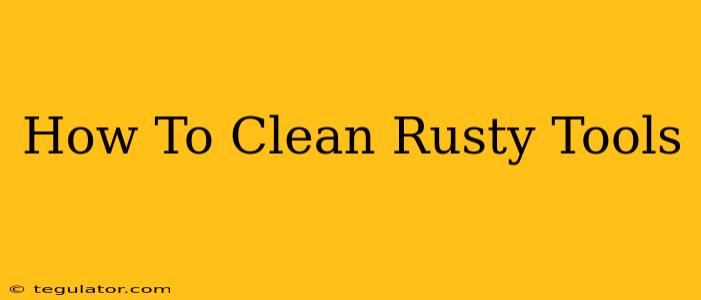Are your favorite tools looking a little worse for wear? Covered in rust and grime? Don't despair! With a little elbow grease and the right techniques, you can bring those trusty tools back to life. This comprehensive guide will walk you through various methods for cleaning rusty tools, from simple solutions for minor rust to more intensive approaches for heavily corroded items.
Assessing the Damage: How Rusty Are Your Tools?
Before you begin, it's crucial to assess the extent of the rust. This will determine the best cleaning method for your tools.
- Light Surface Rust: This is characterized by a thin layer of orange-brown discoloration. Often, simple cleaning methods will suffice.
- Moderate Rust: The rust is more substantial, pitting the metal slightly. More aggressive cleaning techniques will be necessary.
- Heavy Rust: The rust is deep and extensive, potentially causing significant damage to the tool. Restoration may be challenging, and in some cases, replacement might be the best option.
Methods for Cleaning Rusty Tools
Here are several effective methods to tackle rust, ranging from the simplest to the most intensive:
1. Simple Cleaning for Light Surface Rust
For tools with light surface rust, a wire brush and some elbow grease might be all you need.
- Wire Brush: Use a wire brush (preferably a steel brush) to scrub away the loose rust. A rotary tool with a wire brush attachment can be helpful for larger tools.
- Steel Wool: Fine steel wool can also be effective for removing light rust from delicate tools.
- Cleaning Solution: After brushing, wipe the tool down with a cloth dampened with a mild detergent solution. This removes any remaining debris.
2. Vinegar Soak for Moderate Rust
Vinegar is a surprisingly effective rust remover. Its acidity helps to dissolve the rust without damaging the underlying metal (though prolonged exposure can still be harmful).
- Soaking Method: Submerge the rusty tool in white vinegar (the higher the percentage of acetic acid, the better). Soaking time varies depending on the extent of the rust; allow anywhere from a few hours to overnight or even longer.
- Scrubbing: After soaking, use a wire brush or steel wool to remove the softened rust.
- Rinse & Dry: Thoroughly rinse the tool with water and dry it immediately to prevent further rust formation.
3. Baking Soda Paste for Stubborn Rust
For stubborn rust that doesn't readily yield to vinegar, a baking soda paste can be effective.
- Paste Preparation: Mix baking soda with water to create a thick paste.
- Application: Apply the paste to the rusty areas and let it sit for several hours or overnight.
- Scrubbing: Use a wire brush or steel wool to scrub away the loosened rust.
- Rinse & Dry: Rinse thoroughly with water and dry completely.
4. Commercial Rust Removers for Heavy Rust
For heavily rusted tools, commercial rust removers are often necessary. These products are designed to effectively dissolve rust without harming the metal. Always follow the manufacturer's instructions carefully. Many of these products involve similar soaking and scrubbing methods as with vinegar.
5. Electrolysis for Advanced Rust Removal
Electrolysis is a more advanced technique best suited for heavily rusted tools and is particularly good for delicate or antique items. This method requires a specific setup involving an electrolyte solution (typically baking soda and water), a power source, and a cathode (usually a piece of scrap metal). It's a longer process but can be very effective. Plenty of tutorials are available online if you wish to try this method.
Protecting Your Cleaned Tools
Once you've cleaned your tools, it's important to protect them from future rust:
- Thorough Drying: Ensure your tools are completely dry before storage.
- Lubrication: Apply a light coat of oil (such as WD-40 or a specialized tool oil) to prevent future rust.
- Proper Storage: Store your tools in a dry, well-ventilated area.
Conclusion: Giving Your Tools a New Lease on Life
With the right approach, you can effectively clean and restore your rusty tools. Remember to choose the cleaning method appropriate for the level of rust, and always prioritize safety. With a little patience and the right techniques, your tools will be back in top condition, ready for your next project!

